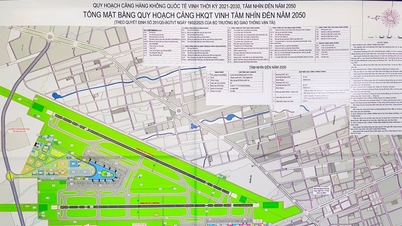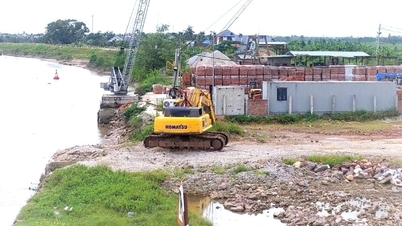
According to experts, to be successful, the amended law must both overcome old bottlenecks and not create new barriers. Above all, the new law must aim to establish a synchronous, modern planning ecosystem with the capacity to lead national development in the long term. It is expected that the National Assembly will consider and pass this important law project, which is especially awaited by localities and businesses, at the 10th Session of the 15th National Assembly.
Exposing shortcomings
The Planning Law was passed by the National Assembly in 2017 and took effect in 2019 with the mission of ending the fragmented, overlapping and unsynchronized planning that has existed for decades. The clear orientation on building an integrated, unified planning system horizontally and vertically has been considered a breakthrough in legislative thinking about development space.
However, after nearly 5 years of application, many localities and central agencies still face difficulties in realizing the principles of integration, leading to a situation of "collecting information" instead of analyzing the overall space. In many planning documents, population, land or industrial indicators are accumulated far beyond national capacity, reflecting a lack of coordination and lack of practical basis.
Dr. Truong Van Quang - Deputy General Secretary of the Vietnam Urban Planning and Development Association commented that integrated regulations are a big step forward in thinking, but without support tools and a synchronized database, implementation can easily go astray or become formalized.
Difficulties have been recorded from the practical implementation of the Law, from conflicts between types of planning (provincial, sectoral, and overall), to the ambiguity in the process of establishment, appraisal, and adjustment, or the lack of unified guidance in decentralization of implementation.
A new hot spot that has recently emerged is the reorganization of provincial administrative units - reducing from 63 to 34 provinces and cities by 2025, putting a series of approved plans at risk of becoming "outdated". Without a flexible legal mechanism for appropriate adjustments, hundreds of development plans, public investments and key projects may be stalled.
Director of the Vietnam Real Estate Research Institute Bui Van Doanh analyzed that if there is no mechanism to both maintain inheritance and ensure adaptability, the upcoming administrative changes will force many plans to be rewritten from the beginning, which is costly and slows down the progress of local development.
Therefore, the direction of amending the law must not only overcome, but also create a breakthrough. It is expected that the National Assembly will consider and approve the draft Law on Planning (amended), in which the Ministry of Finance - the agency assigned to preside over the drafting - has also proposed many fundamental changes.
Do not let planning continue to be a barrier
Some key points of amendment include: Adjusting the entire planning system after merging administrative units, but still ensuring that the implementation of current plans is not interrupted. At the same time, clarifying the legal order and the relationship between planning types, clearly identifying the national master plan as the highest orientation, serving as the basis for lower levels.
Along with the separation between horizontal and vertical integration planning, instead of "merging" as is currently done, it allows independent specialized planning in specific fields (defense, energy, transportation...), if integration is not feasible.
Notably, the amended Law also reduces the time for provincial planning from 30 to 24 months, while shortening the process and simplifying administrative procedures; adding a mechanism to handle conflicts between plans, ensuring consistency and avoiding legal conflicts; promoting decentralization to localities, along with accountability and post-audit; enhancing information transparency and application of digital data, moving towards building an open, transparent and interconnected national planning data system...
In addition, the draft amendment also expands the scope of application by adding a group of technical and specialized planning and separating marine spatial planning into an independent group, increasing the total number of national planning groups from 4 to 5. This addition not only helps the planning system reflect diverse development practices, but also creates conditions for specialized technical fields to have their own legal space, avoiding being "compressed" into an integrated model that lacks flexibility.
Dr. Nguyen Si Dung - former Deputy Head of the National Assembly Office commented that this law amendment is not simply a technical adjustment, but an opportunity to restructure the planning system in a more modern, transparent and effective direction. To do so, we must shift from rigid planning thinking to adaptive planning. The new law must create a corridor for data and technology to become the foundation, not just a supporting tool.
Previously, many localities reflected that even with good regulations, the capacity to organize implementation at the grassroots level remains a challenge. Integrated planning requires a team of consultants with multidisciplinary knowledge, modern analytical tools and updated data - factors that not all provinces are ready to meet.
According to the survey, more than 70% of consulting units currently have no experience in implementing integrated planning in the true sense, mainly "cutting and pasting" from previous sectoral plans. This requires the early establishment of a mechanism for assessing the quality of consulting, possibly through competitive bidding, independent evaluation and publicizing the results.
Therefore, the key point emphasized by many experts is that if the law is not amended promptly and effectively, planning may continue to be the biggest obstacle to development – instead of the driving force as originally intended. Reality from the period 2021-2023 shows that many large projects have been delayed due to slow approval of provincial planning; even some key national infrastructure projects cannot be implemented because of unsynchronized planning procedures.
According to Associate Professor Dr. Hoang Van Cuong - Professor Dr. Hoang Van Cuong, Member of the Prime Minister's Policy Advisory Council, Member of the National Economic and Financial Committee, amending the Planning Law cannot be approached in a patchwork manner but needs to be placed in the overall innovation of thinking about national spatial development. Vietnam needs a law suitable for a country that is rapidly moving into a period of strong urbanization, green transformation and digital transformation.
Source: https://baotintuc.vn/kinh-te/sua-luat-quy-hoach-loai-bo-bat-cap-cu-tranh-phat-sinh-diem-nghen-moi-20251009184529690.htm


![[Photo] President Luong Cuong attends the 80th Anniversary of the Traditional Day of Vietnamese Lawyers](https://vphoto.vietnam.vn/thumb/1200x675/vietnam/resource/IMAGE/2025/10/09/1760026998213_ndo_br_1-jpg.webp)

![[Photo] Prime Minister Pham Minh Chinh chairs a meeting of the Government Standing Committee on overcoming the consequences of natural disasters after storm No. 11](https://vphoto.vietnam.vn/thumb/1200x675/vietnam/resource/IMAGE/2025/10/09/1759997894015_dsc-0591-jpg.webp)


![[Photo] General Secretary To Lam visits Kieng Sang Kindergarten and the classroom named after Uncle Ho](https://vphoto.vietnam.vn/thumb/1200x675/vietnam/resource/IMAGE/2025/10/09/1760023999336_vna-potal-tong-bi-thu-to-lam-tham-truong-mau-giao-kieng-sang-va-lop-hoc-mang-ten-bac-ho-8328675-277-jpg.webp)




























































































Comment (0)